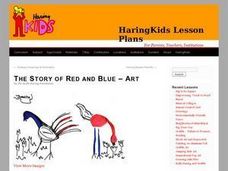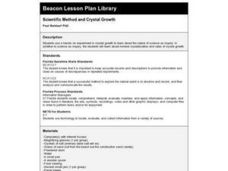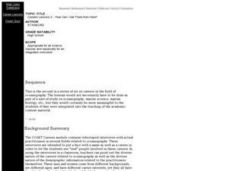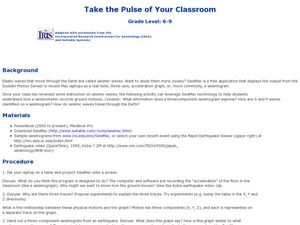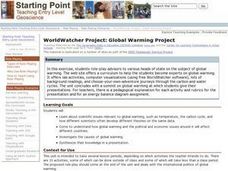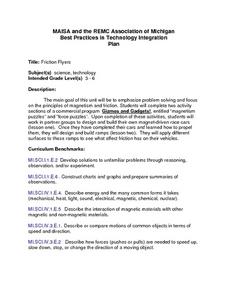Curated OER
The Story of Red and Blue: Art
Middle schoolers identify art history by examining a list of images on-line. In this painting lesson, students identify the work of Keith Haring by researching the Internet and discuss his style of artwork. Middle schoolers utilize...
Curated OER
Scientific Method and Crystal Growth
Learners conduct a hands-on experiment growing crystals to demonstrate the nature of science as inquiry. They discuss and test variables that affect crystal growth. They research mineral crystallization and mineral formation on the...
Curated OER
Butterfly Adventure
Students in second grade are paired with fifth grade computer research buddies. They observe the characteristics of caterpillars, and identify the four stages of the caterpillar to butterfly life cycle. They graph the number of...
Curated OER
E-Cycling!
Eighth graders research how and why electronics are recycled. In this earth science lesson, 8th graders determine the types of materials electronic devices are made up of. They produce a creative ad to encourage people to recycle.
Curated OER
Nature's Recycling Program
Students identify what materials make up compost. In this science of recycling lesson, students explain the benefits of composting determine how compost is a good plant fertilizer.
Curated OER
Evolution Lab
Students examine the pattern of natural variation in a society. They examine Darwin's theory of evolution and analyze data. They use computer programs to graphically display the variation in organisms.
Curated OER
Eureka! I’ve Got an Idea!
Students explore many inventions and inventors. In this science activity, students collaborate as they research inventors and their times in order to compile information to build an informative Web site.
Curated OER
Concrete Research
Students explore concrete. In this physical science and computer research lesson, students work in groups to answer specific questions about concrete. Each group of students completes a different worksheet with a specific subtopic....
Curated OER
Careers Lessons 2 - How Can I Get There from Here?
Students identify differences between jobs and careers, and identify career areas within the broad field of oceanography. They research, compare and contrast requirements needed to become a practitioner of various oceanographic career...
Curated OER
Focus on Food Chains
Third graders collect and analyze data about food chains. They conduct Internet research about the habitat of a selected organism, write a narrative, and create a computer slideshow using Kid Pix computer software that illustrates the...
Curated OER
Rainforest Animals
Third graders make a presentation or a booklet to help class learn about rain forest animals. They sketch or use a few words to describe the picture that goes with the facts. They use the computer to make a presentation or use...
Curated OER
Ladybugs
Third graders keep and report records of investigations and observations of ladybugs utilizing tools like journals, charts, graphs and computers. They discover and study the life cycle of ladybugs and complete a KWL chart about ladybugs.
Curated OER
In The Zone
Third graders identify ways that ocean animals grow, survive, reproduce, and adapt. They use computer Internet skills to acces and collect information. They create a PowerPoint presentation. They demonstrate writing skills throughthe...
Curated OER
Galaxies Galore, Games and More
Students practice skills used in scientific investigation while studying the three main types of galaxies. Students identify Earth as part of Milky Way galaxy, the parts of galaxies, and the types of galaxies, as well as classify...
Curated OER
Quicksand Questions: Short In-class Activity
Students are prompted with questions during a lecture on quicksand. Student answers can be collected with classroom response systems. The responses (both individual and the class as a whole) are recorded on the instructor's computer....
Curated OER
Cell Transport & Reproduction
Students are able to define the following terms: Osmosis, Isotonic Solution, Hypotonic Solution, Hypertonic Solution and Passive Transport. They read and complete a Mitosis worksheet, and play a Cell COmputer Game.
Curated OER
Bacteria and Illness
Students research information on bacterium and their relationship to food borne diseases. In this science lesson plan, students complete internet research to construct and analyze the growth cure of common bacterium...
Curated OER
Take the Pulse of Your Classroom
Students discuss seismic waves. In this science lesson, students investigate the acceleration of the floor in the classroom similar to a seismograph. Students observe a three-component seismogram from an earthquake and determine what it...
Curated OER
Concept Structures in Architecture
Students develop a creative building design. In this technology lesson, students create a model of their building using a computer software. They present their final product in class.
Curated OER
Are We Couch Potatoes or Busy Bees? Data Analysis of Physical Activity in School
Students study practical data analysis within the constraints of the scientific method. In this data lesson students collect and enter data into a computer spreadsheet then create graphs.
Curated OER
WorldWatcher Project: Global Warming Project
Students conduct lab activities, computer visualizations, and other various forms of research in preparation for a role-play activity in which they assume the identities of advisors to various heads of state on the subject of global...
Curated OER
What is the purpose of Karyotyping?
Students explain how karyotyping is used to diagnose specific genetic disorders. They use karyotypes to make observations and analyze chromosomal errors. This activity can be completed online or without computer access.
Curated OER
Friction Flyers
Young scholars explore the principles of magnetism and friction. They complete an interactive puzzle on the Gizmos and Gadgets computer software, construct a vehicle, build and modify ramps and vehicles to produce various outcomes, and...
Curated OER
Discovering Ohm's Law
Students explore the relationship of resistance, voltage, and current in series and parallel circuits using a computer model of a circuit board. They discover Ohm's Law by constructing series circuits.
